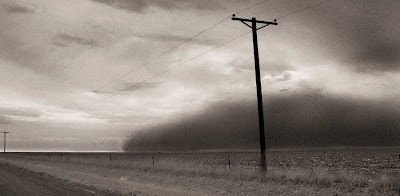Click to enlarge photos.
There's a place in the northwest Texas Panhandle which includes the entire Oklahoma Panhandle known as "no man's land." It's called that because it was basically abandoned due to the Dust Bowl. What was once promising green grassland became a veritable desert of dust and death due to an unprecedented period of drought and bad land management during what was called "The Dirty Thirties.
I explored the Oklahoma & Texas panhandle extensively during a location scout for Ken Burns/Dayton Duncan production to air on PBS this November titled "The Dust Bowl."
"Let me tell ya how it was. I don’t care who describes that to you, nobody can tell it any worse than what it was. And no one exaggerates that; there is no way for it to be exaggerated. It was that bad.”
— Don Wells, Boise City, Oklahoma
Although through careful water and land management the wild grasses have returned to hold down much of the top soil - the recent drought - rivaling that of the 1930s, threatens to turn the area again into a new Dust Bowl. Wildfires sparked by lightning have ravaged the area - stripping the ground of the protective grasses that hold down the prairie. Huge billows of ash and dust are lifted up thousands of feet whenever a "blue norther" comes through - carrying it as far south as Lubbock and Midland also suffering from the drought.
Last year (2011) was the dryest on record, even surpassing those powder dry days of the 1930s. Fortunately 2012 has been kinder. Rainfall is up and for awhile the Great Plains were green this past spring, but as we approach autumn, the water has dried up and once again is becoming fuel for the inevitable prairie fires that will sweep the High Plains during February, March and April of 2013.
I found this abandoned homestead just outside of the town of Texline on the Texas/New Mexico border.
The years have not been kind to what have once been some family's dream home - but now it sits empty - a reminder of the optimism of those early farmers and ranchers who saw great promise in what was once an ocean of green prairie grass only to have it slowly erode into what now is No Man's Land.
In my opinion it should be preserved as an official historical site, as an example of what life was like during the Dirty 30s, but nature didn't concur.
All photos (C) Steve Douglass
Although you can still drive miles and miles without seeing a living soul, you still can find traces of the Dust Bowl or echoes - as I call them - that reverberate through the region to this day.
I came upon this abandoned "Jail Break Ford" in ranchers field. It is surrounded by cattle bones, the remains of cows that died huddling around it because it is the only wind break on a featureless plain. In winter the howling winds give no quarter and can literally freeze the flesh and strip away.
I imagine a scenario where this truck was a farm truck - tasked with taking wheat to market - but when the grass dried up and blew away - so did the money to maintain it. Most likely when it broke down sixty some-odd years ago it was abandoned in place and has been there ever since.
More photos of this unofficial monument to the Dust Bowl will be posted later in this blog.
I found this abandoned homestead just outside of the town of Texline on the Texas/New Mexico border.
The years have not been kind to what have once been some family's dream home - but now it sits empty - a reminder of the optimism of those early farmers and ranchers who saw great promise in what was once an ocean of green prairie grass only to have it slowly erode into what now is No Man's Land.
In my opinion it should be preserved as an official historical site, as an example of what life was like during the Dirty 30s, but nature didn't concur.
I hear it was swept away by a tornado last year.
All photos (C) Steve Douglass








